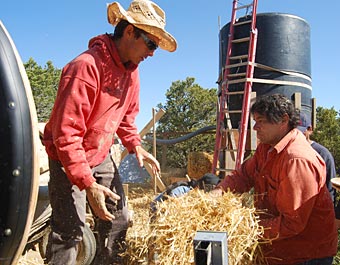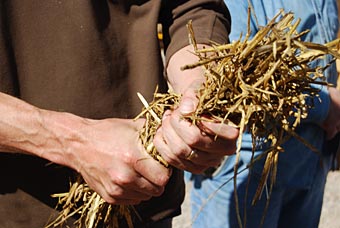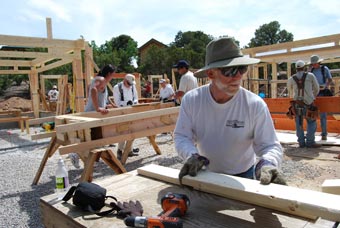Building green for less green: Design team plans lower-cost, energy-efficient housing
In construction, affordable and green are often contradictory terms. What makes for an environmentally conscious building — such as the use of natural building materials or systems to generate alternative forms of energy — often also makes for an expensive one, leaving sustainable design a choice only a few can afford.

Rick Miller, a member of the Lac Courte Oreilles tribe of Wisconsin, works alongside a staff member of EcoNest, a New Mexico-based sustainable design and building firm, loading a specially designed hopper to produce material for a straw/clay structure. The team is building two model homes at Lac Courte Oreilles, near Hertel, Wis., that demonstrate design techniques that are both environmentally friendly and affordable. The project is part of a course on green design taught by Sue Thering, a UW–Madison assistant professor of landscape architecture.
— Photos by Dee Finnegan
A team of faculty, students and community organizations, however, is out to construct a new reality: green housing that doesn’t require as much up-front expense.
Sue Thering, a UW–Madison assistant professor of landscape architecture and a community development specialist for UW-Extension, is coordinating a partnership with several of Wisconsin’s Native American communities to create affordable, energy efficient housing on tribal lands throughout the state.
Supported by a three-year grant from the Baldwin Wisconsin Idea Endowment, the project led to a for-credit outreach program this summer, which trained 20 participants in green community design techniques and will culminate in the construction of two model homes in the St. Croix Ojibwa community near Hertel, Wis. Plans are to construct affordable housing in other tribal communities during the next three years.
"There are green technologies that already go into very high-end housing," says Thering. "We have assembled a team of national experts who have dedicated themselves to this project, and through good design, research and testing, they have made these technologies work on a more modest scale."

Quality control is a hands-on operation performed by Roger Smith of Madison’s Design Coalition. Testing the straw/clay combination throughout the process is critical in the application and construction of light straw/clay building.
Thering notes, for example, that some builders in the Southwest are using light straw clay, a mixture of straw and clay that can be molded like adobe, to construct "green" walls in expensive homes. Participants in the summer program – including UW–Madison students, employees of tribal housing offices, and other tribal leaders and members – spent a week in Santa Fe, N.M., learning how to work with light straw clay, which can be adapted for Midwestern temperatures to create highly energy efficient structures.
By mastering such techniques, Thering says participants can open the door to jobs and business opportunities. "Builders tell us that there is pent-up demand for these technologies, but a shortage of people who are trained to work with them," she says. "We’re responding to the market."
Wisconsin’s 11 recognized Native American tribes, sometimes referred to as First Nations, make ideal partners for exploring environmentally conscious housing, says Thering. She notes that several tribes, including the St. Croix Ojibwa, the Sokaogon Mole Lake Ojibwa and the Lac Courte Oreilles Ojibwa communities, have contributed to the project. UW faculty are also working with the newly formed Sustainable Living Institute at the Lac Courte Oreilles Ojibwa Community College to design a multi-use building that will eventually house conventions and visitors.

Shawn Kelly, of Kelly Design Group, works closely with builders from various Wisconsin tribes and student volunteers. In his role as a faculty associate of the UW–Madison landscape architecture department, he trades in his hammer for a flip chart when he provides on-site field workshops relating to sustainable land use practices.
"Nowhere else in the state was there such leadership and talented staff willing to do the training specifically in green affordable housing," she says. "The tribes stepped up and have invested heavily."
Thering’s introduction to green housing came during the 1970s energy crisis, when she struggled to pay the bills to heat and cool her drafty, aging farmhouse. Her search for a way to build more energy-efficient homes led her to enroll in architecture school. While interest in energy efficient technologies has grown more mainstream, Thering says there is still little consumer pressure on builders to make those technologies less costly to install. For green design to become widely affordable, consumers need to understand its benefits. Then, she says, the market will respond.
"We have to understand that energy costs are never going to drop again," says Thering. "We have to build green and energy-efficient from the land up."
Green building benefits the environment by using recycled materials and renewable resources such as wood, straw and clay in construction. It also promotes the use of materials created and produced locally, limiting transportation costs and fossil fuel consumption.
But the benefits of a green community can go far beyond lower energy costs, says Shawn Kelly, a faculty associate and principal of Kelly Design Group, who is working with Thering on the project. Green housing can also be culturally significant, which is another reason that UW’s design team has worked with First Nation communities. Kelly says that green design complements tribe members’ cultural identity by incorporating their traditional building practices – solar energy technology, for instance, is compatible with the tribal significance of the four cardinal directions.
Additionally, culturally significant plants can be integrated into building materials or surrounding vegetation, he says. As part of the project, Kelly and his landscape architecture students are collaborating with tribal officials to plan streets that complement natural land topography, sun position and water movement, an approach that manages storm water to reduce pollution and erosion and sustain vegetation.
For the homeowner, that means access to solar power, a prosperous garden and natural indoor lighting, says Kelly. For the community, it means sustainable development in its purest sense.
The other members of the UW–Madison green design team are architect Lou Host-Jablonski, senior outreach specialist and principal of Design Coalition, Inc., and chemical engineer Douglas Piltingsrud, senior research associate and principal of Sustainable Housing Research, Inc. Steve Kozak, director of the Lac Courte Oreille Ojibwa Community College Sustainable Living Institute, is also a key partner on the collaborative effort.
Subscribe to Wisconsin Ideas
Want more stories of the Wisconsin Idea in action? Sign-up for our monthly e-newsletter highlighting how Badgers are taking their education and research beyond the boundaries of the classroom to improve lives.




